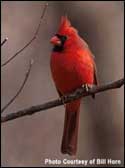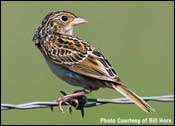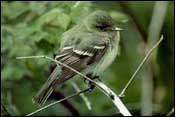The Guide to
Austin-area Birding Sites
Good places to see birds in and around Austin
Southwest Areas

12. Wild
Basin Wilderness Preserve -
805 North Capital of Texas
Highway, Austin TX 78746,
(512) 327-7622
Location: From Loop 1
(MoPac Expressway): Go
west on RM 2244 (Bee Cave
Rd.) for 3.6 miles to
the intersection with
Loop 360 (Capital of Texas
Highway). Turn right (north)
onto Loop 360 and follow
it for 1.1 mile to Wild
Basin, on the right. Or:
Driving south on Loop
360, go 3.1 miles past
the Colorado River; Wild
Basin will be on the left.
Habitats: Oak-juniper
woodland. Riparian habitat
along Bee Creek. Wild
Basin hosts such typical
birds of the Texas Hill
Country as Western
Scrub-Jay, “Black-crested” Titmouse,
Bewick’s
Wren, and
Northern
Cardinal. A few
Golden-cheeked
Warblers may be heard singing early
in the breeding season,
but they are probably
no longer regular nesters.
(Black-capped
Vireos still
nest on the adjacent Vireo
Preserve, but this area
is closed to the public—please
do not trespass.)
Facilities: Nature center,
gift shop, trails (some
of them wheelchair accessible),
interpretative programs
for adults and children,
restrooms. Bird checklist
available. Voluntary entrance
fee.

13. Pace
Bend County Park (Paleface
Park) - 2011
North Pace Bend Rd., Spicewood
TX 78669, (512) 264-1482
Location: From the Texas
Highway 71/RM 620 junction
in Bee Cave, follow Texas
71 west for 15 miles to
the intersection with
RM 2322. Turn right (north)
onto RM 2322 and follow
it 4 miles to the Park
entrance.
Habitats: Lake and lakefront.
Other Park habitats, such
as mesquite savannahs
and cactus patches, show
western dryland influences.
Look for resident Golden-fronted
Woodpeckers near the entrance
station; a number of sparrows
overwinter in fields near
the station, including
Grasshopper
Sparrow. In
the Maxey Cove area, Canyon
Wrens, Canyon
Towhees,
and Rufous-crowned
Sparrows are resident and Cactus
Wrens are often found.
At Mudd Cove look for
nesting Cactus
Wrens and
Bell’s Vireos; American
Pipits overwinter. Bushtits are resident in the center
of the Park. Pyrrhuloxias sometimes (and Common
Ravens more often) occur
in the Park during winter.
Forster’s
Terns are regular over Lake
Travis during migration
and winter; Ospreys are
also regular, but less
common.
Facilities: Map, trails
(some of them wheelchair
accessible), restrooms,
picnic area. Swimming
and camping. Entrance
fee.
Further
exploration: The
nearby Haynie Flat Rd.
area supports many of
the species found in the
Park; Verdins have also
been reported here.

14. Hamilton
Pool County Park -
24300 Hamilton Pool Rd.,
Dripping Springs TX 78620
(512) 264-2740
Location: Follow Texas
Highway 71 west to Hamilton
Pool Rd. (RM 3238). Turn
left (south) onto Hamilton
Pool Rd. and follow it
for about 13 miles to
the Park entrance, on
the right.
Habitats: Oak-juniper
woodland; some restored
grasslands. Along Hamilton
Creek and the Pedernales
River, riparian habitats
with Bald Cypress. Hamilton
Pool is a cavern whose
roof collapsed long ago,
leaving it open to the
sky; Hamilton Creek flows
into the pool as a waterfall.
Canyon
Wrens are permanent
residents around the Pool.
Downstream from the Pool,
the Hamilton Creek area
supports such locally
uncommon nesters as Acadian
Flycatcher and Louisiana
Waterthrush. Golden-cheeked
Warblers also nest near
the Creek.
Facilities: Map, trails,
restrooms, swimming. Bird
checklist available. Entrance
fee. The Park closes to
additional visitors when
the parking lot fills
to capacity (often the
case on weekends).
Further
exploration: The
Westcave
Preserve is a
bit farther down Hamilton
Pool Rd. (take the first
gate on the right past
the Pedernales River).
The Preserve offers weekend
walks, introducing visitors
to the Hill Country’s
environment; these are
at 10 and 12 a.m. and
2 and 4 p.m., weather
permitting. Wear appropriate
footgear. Donations are
accepted. Telephone: (830)
825-3442.
Austin-area Birding Sites
Texas Parks and Wildlife Department
4200 Smith School Road
Austin, TX 78744
or send a message to: nature@tpwd.texas.gov